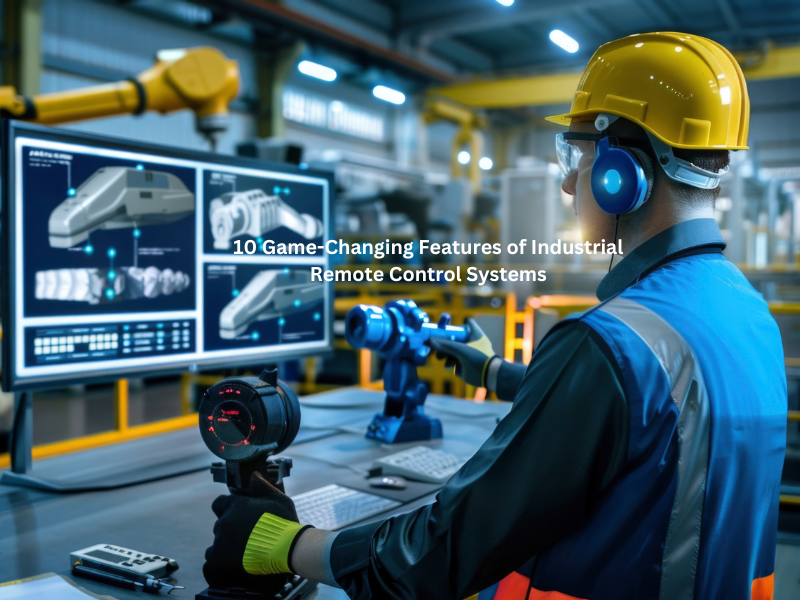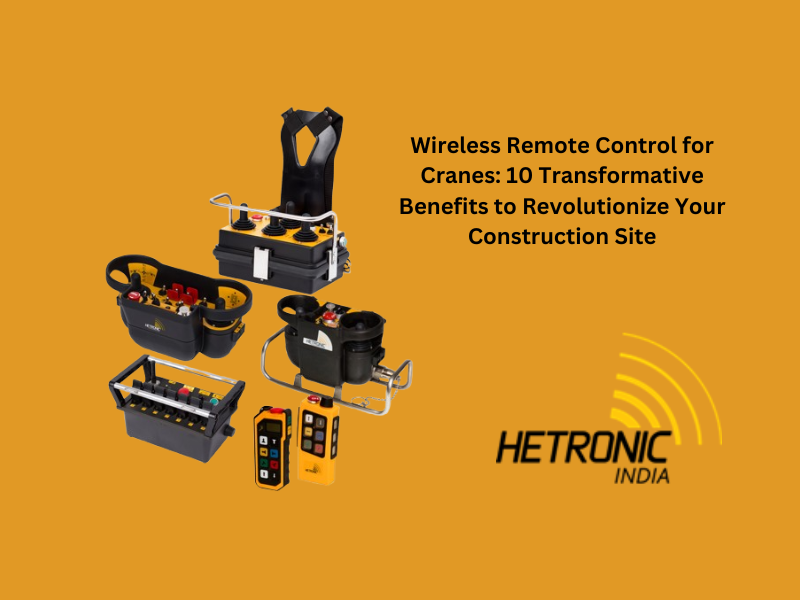Introduction – Industrial Remote Control Systems
In today’s rapidly evolving industrial landscape, staying ahead of the curve is no longer a luxury—it’s a necessity. Enter industrial remote control systems, the unsung heroes of modern manufacturing and process industries.
These sophisticated tools are revolutionizing the way businesses operate, offering unprecedented levels of control, efficiency, and safety. But what exactly makes these systems so indispensable? In this comprehensive guide, we’ll dive deep into the 10 key features of industrial remote control systems that you absolutely need to know.
Whether you’re a seasoned industry veteran or just beginning to explore the possibilities of remote control technology, this article will equip you with the knowledge to make informed decisions and propel your operations into the future.
1. Real-Time Monitoring and Control
Gone are the days of delayed responses and outdated information. Modern industrial remote control systems offer real-time monitoring and control capabilities that keep you in the driver’s seat, no matter where you are.
Why It Matters
– Instant Decision Making: With up-to-the-second data at your fingertips, you can make critical decisions without delay.
– Proactive Problem Solving: Identify and address issues before they escalate, minimizing downtime and maximizing productivity.
– Optimized Resource Allocation: Allocate resources more effectively by having a clear, real-time view of your entire operation.
Implementation Tips
– Invest in high-speed, low-latency communication infrastructure to ensure seamless real-time data transmission.
– Train your team to interpret and act on real-time data effectively.
– Regularly review and update your monitoring parameters to ensure you’re tracking the most relevant metrics.
2. Advanced Data Analytics and Visualization
In the age of big data, simply collecting information isn’t enough. Leading industrial remote control systems come equipped with powerful analytics tools and intuitive visualization interfaces that transform raw data into actionable insights.
Key Benefits
– Pattern Recognition: Identify trends and patterns that might be invisible to the human eye.
– Predictive Maintenance: Anticipate equipment failures before they occur, reducing unexpected downtime.
– Performance Optimization: Fine-tune your processes based on data-driven insights for maximum efficiency.
Best Practices
– Customize dashboards for different user roles to ensure everyone has access to the information they need.
– Implement machine learning algorithms to continually improve your analytics capabilities.
– Regularly validate and clean your data to ensure the accuracy of your insights.
3. Robust Security Protocols
With great power comes great responsibility. As industrial systems become more connected, the importance of robust security measures cannot be overstated.
Critical Security Features
– End-to-End Encryption: Protect your data from interception and tampering.
– Multi-Factor Authentication: Ensure only authorized personnel can access critical systems.
– Regular Security Audits: Stay one step ahead of potential vulnerabilities.
Security Best Practices
– Implement a comprehensive cybersecurity strategy that includes regular training for all employees.
– Keep all software and firmware up to date with the latest security patches.
– Consider employing a dedicated cybersecurity team or partnering with a reputable security firm.
4. Scalability and Flexibility
In today’s fast-paced industrial environment, the ability to adapt and grow is crucial. Top-tier industrial remote control systems are designed with scalability and flexibility in mind.
Advantages of Scalable Systems
– Future-Proofing: Easily expand your system as your business grows without starting from scratch.
– Customization: Tailor the system to your specific needs, adding or removing features as required.
– Cost-Effectiveness: Scale your investment in line with your business growth.
Implementation Strategies
– Choose a modular system that allows for easy addition of new components.
– Opt for cloud-based solutions that can scale quickly without significant hardware investments.
– Regularly reassess your system requirements and adjust your setup accordingly.
5. Seamless Integration with Existing Systems
The best industrial remote control systems don’t operate in isolation. They seamlessly integrate with your existing infrastructure, creating a cohesive ecosystem of industrial technology.
Integration Benefits
– Unified Operations: Break down silos between different departments and processes.
– Enhanced Efficiency: Eliminate redundant data entry and streamline workflows.
– Comprehensive Insights: Get a holistic view of your entire operation in one place.
Integration Tips
– Conduct a thorough audit of your existing systems before implementing a new remote control solution.
– Look for systems with open APIs and standard protocols to ensure compatibility.
– Consider working with a systems integrator to ensure a smooth transition.
6. Mobile Accessibility
In an increasingly mobile world, the ability to monitor and control your industrial processes from anywhere is a game-changer.
Mobile Features to Look For
– Responsive Design: Ensure the interface is optimized for various screen sizes.
– Offline Capabilities: Access critical information even when internet connectivity is limited.
– Push Notifications: Stay informed of important events in real-time.
Mobile Best Practices
– Implement strict mobile device management policies to ensure security.
– Provide thorough training on mobile app usage to maximize adoption and effectiveness.
– Regularly gather feedback from mobile users to continually improve the mobile experience.
7. Predictive Maintenance Capabilities
One of the most revolutionary features of modern industrial remote control systems is their ability to predict and prevent equipment failures before they occur.
The Power of Prediction
– Reduced Downtime: Schedule maintenance during off-peak hours to minimize disruption.
– Extended Equipment Lifespan: Identify and address minor issues before they become major problems.
– Optimized Maintenance Budgets: Focus resources where they’re needed most.
Implementing Predictive Maintenance
– Start by establishing baseline performance metrics for all critical equipment.
– Invest in sensors and IoT devices to gather comprehensive data on equipment health.
– Develop and continuously refine predictive models based on historical data and machine learning algorithms.
8. Automated Reporting and Compliance Management
Staying compliant with industry regulations and producing accurate reports can be a time-consuming task. Advanced industrial remote control systems take the pain out of this process with automated reporting features.
Reporting Advantages
– Time Savings: Generate complex reports at the click of a button.
– Accuracy: Eliminate human error from the reporting process.
– Customization: Tailor reports to meet specific regulatory or stakeholder requirements.
Compliance Best Practices
– Stay informed about changing regulations in your industry and update your system accordingly.
– Implement version control for all reports to maintain an audit trail.
– Regularly review and validate your automated reports to ensure ongoing accuracy.
9. Energy Management and Sustainability Features
As industries face increasing pressure to reduce their environmental impact, leading remote control systems are incorporating advanced energy management and sustainability features.
Sustainability Benefits
– Reduced Energy Consumption: Optimize processes to minimize energy waste.
– Carbon Footprint Tracking: Monitor and report on your environmental impact.
– Renewable Energy Integration: Seamlessly incorporate renewable energy sources into your operations.
Implementation Strategies
– Conduct an energy audit to identify areas for improvement.
– Set clear, measurable sustainability goals and use your remote control system to track progress.
– Consider partnering with sustainability experts to maximize the impact of your efforts.
10. Collaborative Tools and Knowledge Management
The most advanced industrial remote control systems go beyond simple monitoring and control, offering collaborative tools that enhance communication and knowledge sharing across your organization.
Collaboration Features
– Integrated Messaging: Facilitate real-time communication between team members.
– Knowledge Bases: Create and maintain a centralized repository of best practices and troubleshooting guides.
– Remote Assistance: Enable experts to provide guidance from anywhere in the world.
Fostering Collaboration
– Encourage a culture of knowledge sharing and continuous improvement.
– Implement regular training sessions to ensure all team members are making the most of collaborative features.
– Create clear guidelines for documentation and knowledge management to maintain consistency.
Conclusion – Industrial Remote Control Systems
Industrial remote control systems have come a long way from their humble beginnings. Today, they represent the cutting edge of industrial technology, offering unprecedented levels of control, efficiency, and insight.
By embracing these 10 key features—real-time monitoring, advanced analytics, robust security, scalability, seamless integration, mobile accessibility, predictive maintenance, automated reporting, energy management, and collaborative tools—you can transform your industrial operations and stay ahead in an increasingly competitive landscape.
As you consider implementing or upgrading your industrial remote control system, remember that the technology is just one piece of the puzzle. Success also depends on having the right strategies, processes, and people in place to make the most of these powerful tools. Invest in training, foster a culture of innovation, and stay open to the possibilities that these systems offer.
The future of industry is here, and it’s more connected, intelligent, and efficient than ever before. Are you ready to unlock the full potential of industrial remote control systems and propel your business into the future?





